High Cost of Not Being Aggressive Enough Without ICMIZER
Contents
You are playing too tight as the big stack on the bubble. You might not think you are, but as we will see today using ICMIZER, most players do not recognise how aggressive they can be. When you have studied ICMIZER in depth, you will learn how to capitalise on a chip lead on the bubble by building a huge stack for the final table.
The Independent Chip Model (ICM) is a formula which enables poker players to convert tournament chips into their real money equity value. That equity is in the form of a percentage of the remaining tournament prize pool. It impacts every decision, particularly late game decisions, in tournaments including the ranges you play, game selection, when to register and what a fair final table deal looks like.
If you missed it, in our last blog we looked at how costly a calling mistake is in the late stages of a tournament. We showed that a bad call that is just one hand outside of the correct calling range could have a severe negative impact on your bottom line. If you have not read that blog yet we implore you to bookmark this article and head over to that one first, because it could save you a small fortune in lost equity.
How does ICMIZER quickly pay for itself for tournament poker players
In that article we looked at the hand grid from ICMIZER that shows you the profitability of each hand in a given spot, then compared the inflection points between a call and a fold, and how big a gulf there is between them. We are going to do something similar today, but with the next big area where tournament players often lose a lot of EV – aggression as the big stack on the bubble.
It is often said that the bubble is where the tournament is won or lost, referring to the opportunity savvy players have to build a big stack. That may be an exaggeration, but you do put yourself in a great position to make the final table if you run over your tablemates on the bubble. Players overfold on the bubble in general but because of the significant ICM pressure it is also correct for them to fold a lot when they could be the last player to exit without a prize. This is a massive opportunity for the fearless player with a big stack. When players are correct to fold most of their range to somebody who covers them, the covering player has a unique opportunity to take down a lot of uncontested pots.
Yet often a big stack leaves a lot of equity on the table, themselves not wanting to risk elimination if a couple of coolers go the wrong way for them. Today we will look at how profitable it is for a big stack to play aggressively on the bubble. A quick reminder on the way we will measure that.
ICM $EV and %EV
ICMIZER 3 has a feature which shows just how significant a good or bad ICM decision is. If you have used the tool before you will have seen this but not noticed how relevant it is. It is the percentage of the prize pool feature that is shown under every single hand in the hand range grid. That little plus or minus below each hand:

Everyone knows that a + is good and a – is bad, just like we intuitively know that red means stop and green means play the hand. But what is this a plus or minus of? It reflects the percentage of the remaining prize pool you win or lose on average.
In the example above, AQs is +0.38 which means on average it will win 0.38% of the remaining prize pool. So if you are at the final table of the Sunday Million and there is $250,000 left to play for, AQs will make you $950 on average in the spot you find yourself in.
If you want you can change the setting on ICMIZER when you select the payout structure in the top left corner to display the actual money amounts rather than the percentage of the prize pool. You just need to manually input the remaining prize pool:


In an ideal world you would always use the ICM %EV setting because these ranges should apply whether you are playing a $1 45-man MTTSNG or the $5,200 WCOOP Main Event. If you are playing 9-man SNGs where the correct move in a $1 SNG or a $109 SNG would be the same, you should certainly use ICM %EV because it will allow you to be more objective moving up the stakes. In reality the size of field and the size of the buy-in has a dramatic impact on your decisions in MTTs so for that reason our examples will be in ICM $EV and we would suggest that might make sense for you too.
Aggression errors
In this first example we are the chip leader on the bubble of an $11 90-man SNG on PokerStars, which is when 14 players remain. We have 44 big blinds and are the Cutoff at a six handed table, the next biggest stack has 25 big blinds.
If you want to replicate this, here are the chip stacks and we used MTT Mode with 14 players left. You can also find the solve here.
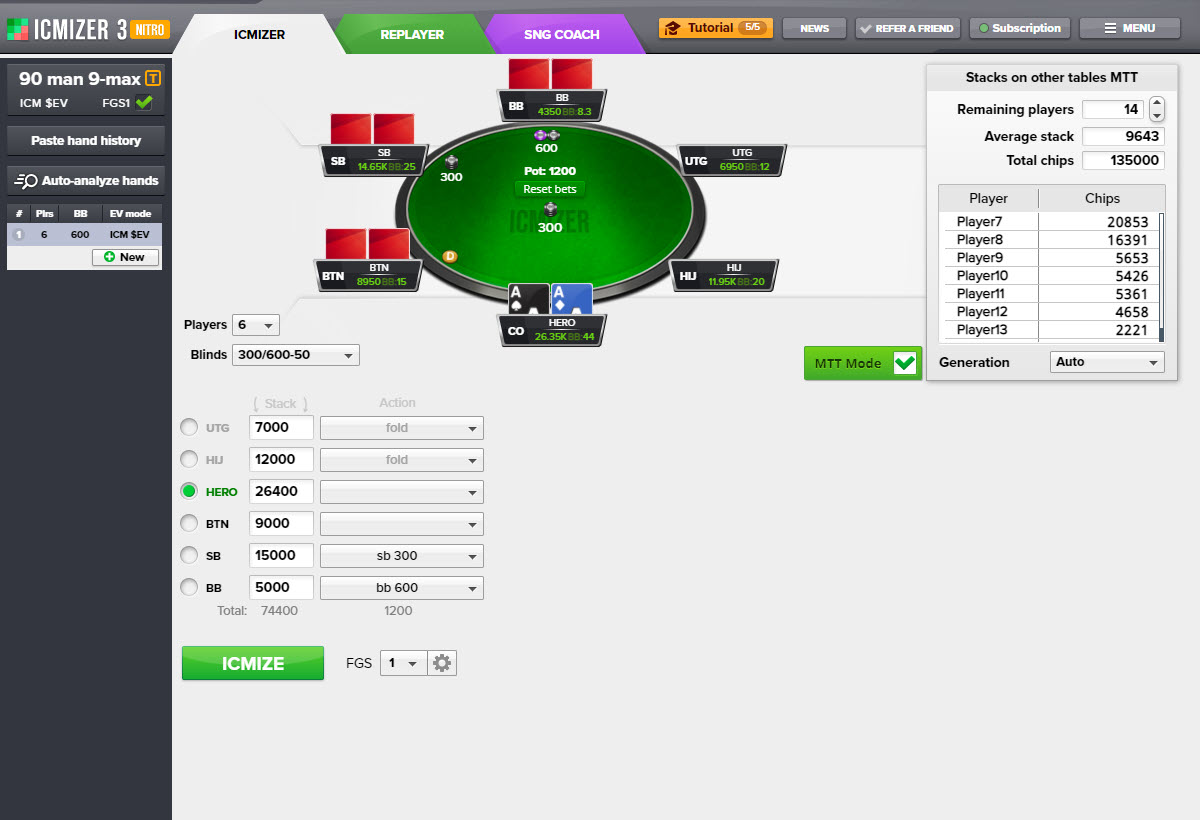
This is a spot where we should be aggressive, it is the bubble and we cannot be eliminated. Our opponents have to play very tight, so we can pick up a lot of uncontested pots.
So what is our shoving range? Before you look at the next picture, think about what your own range would be here. Would you play any Ace? Any King? Most pairs?
This is what the actual ICMIZER approved range looks like:
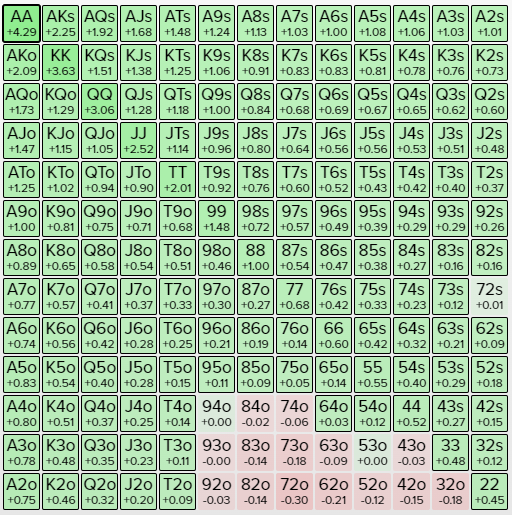
It is incredibly wide, in fact it is almost any two cards. The only thing it is missing is the offsuit junk that doesn’t have any kind of showdown value.
A lot of people might go for something like Any Ace, any pair, all hands with two broadway cards in it, but as you can see that is way too tight. We can profitably shove with 95s and J7o here. Even 32s makes us $0.12 on average.
In some instances shoving with the bottom of your range might not seem worth it. 94o, for example, is a breakeven shove. To lower your variance and also if you suspect your opponents will call wider than they should, ICMIZER allows you to filter for a minimum EV Difference. It’s at the bottom of the hand range grid, and you can set a minimum amount you want to make from each hand in your range. As you can see from our range above, we wanted the hands to at least make us more than breakeven, so although in perfect GTO world 94o and 53o are shoves, they are not in our range.
Why can we shove so wide? Look at the calling range for the Small Blind who has 25 big blinds and is the player who can hurt us the most:
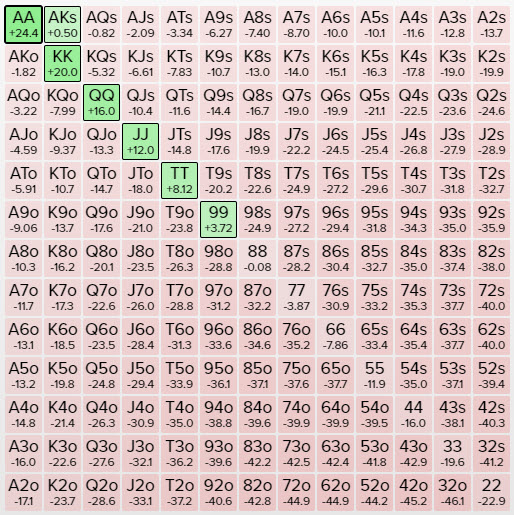
They can only look us up with the best pairs and AKs. It might really surprise you to see that AKo is a clear fold in this spot. It will lose the Small Blind $1.82 on average and AKs only makes them $0.50 on average, so that’s not a snap call either. Because our opponents have to fold so tight against us, it means we can open up so many more hands.
Let’s look back at our shoving range for a moment:
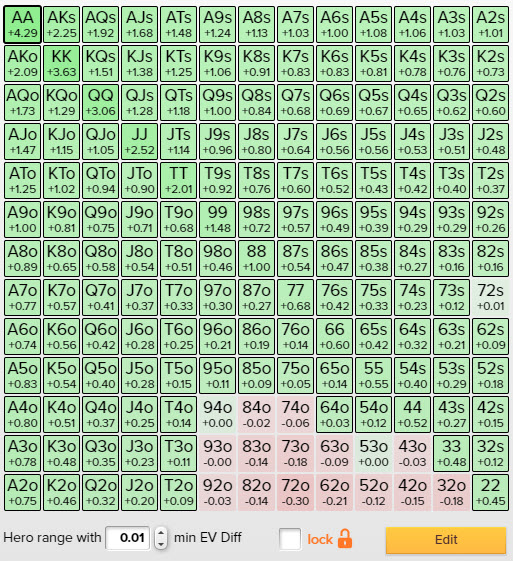
Aces is our most profitable shove and it makes $4.29 on average. T2o is a terrible hand but it still makes us $0.09 on average. 32o is a bad shove and it costs us $0.18 on average, compare that to a bad call for the Small Blind with AJs that costs them $2.09. This is the power of the big stack and being the aggressor. Our bad shoves are never terrible because they can still pick up a small pot a lot of the time, but a bad call by a covered player is devastating for them.
Let’s change the dynamics, this time we are in a $11 MTT with a 300-man PokerStars payout structure from the ICMIZER database. We are on the bubble, which is 46 players remaining. In MTT Mode we have increased the total number of chips from 135,000 to 450,000 to simulate the increased player pool. The stacks and blinds at our tables, however, are the same. So this is an identical example from a chip perspective, but the stakes are higher in terms of total prize pool. You can find the solve here.
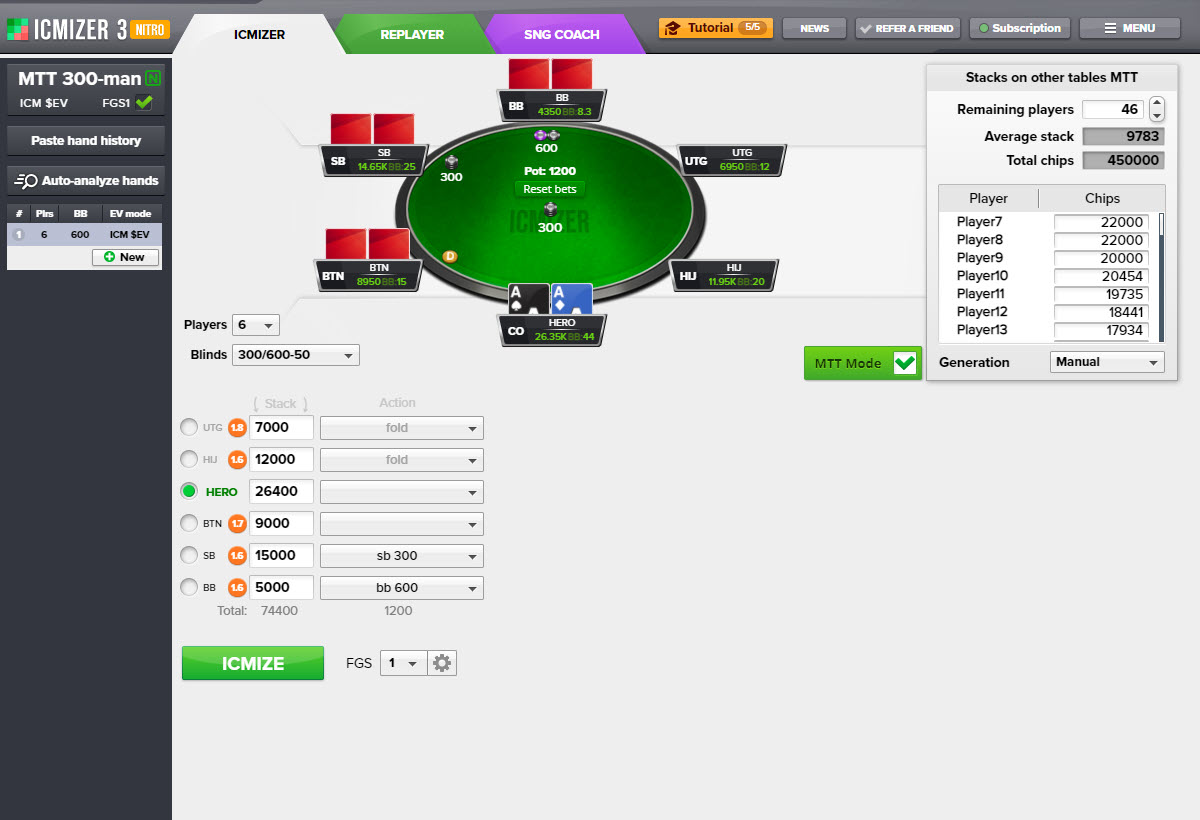
Should we go wider or tighter here as the big stack, given we are in a larger field?
This is the new shoving range:
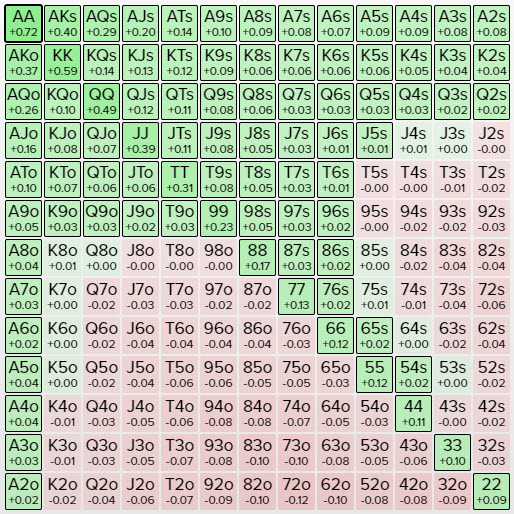
In this instance we cannot push as wide. This payout structure is quite top heavy and going for first prize is much more important than securing a mincash. ICM always has two competing forces dictating the ranges, which is known as ‘laddering’ vs ‘playing for the win’. In this case with $580.50 going to the eventual winner and just $18 going to the mincash. In the 90-man SNG example $248.40 went to the winner and $23.40 went to the mincash, not only was the mincash bigger the difference between that and the top prize was less.
You can see this demonstrated in how much certain hands make compared to the previous example. Aces, for example, makes us $0.72 on average here whereas it made us $4.29 in the 90-man SNG bubble spot. In layman’s terms, this is because you are so much further away from playing for the top prize because you have less of the chips in play relatively and more players to navigate through. In our first example the chip leader had 19.26% of the chips in play, in this example he has 5.87%. If we gave the chip leader the same percentage of chips as in the previous example, you would see a similar, if not wider, shoving range as in the 90-man example.
The Small Blind can also call a little bit wider, they can now call with AJ+ and ATs.
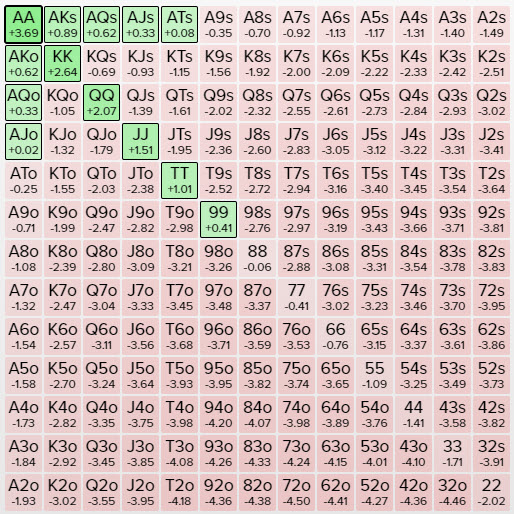
You cannot simply look at one bubble example and apply it to every tournament you play. The payout structure, the different stacks at your table, the stacks on different tables, the number of entrants, the percentage of total chips you have, position and much more all influence each individual range. This is why practicing these spots is so important. At ICMIZER we have an MTT Coach feature that tests you on thousands of different spots in a variety of payout structures. You will develop muscle memory and a sense for what factors tighten or loosen your ranges very quickly. It’s a feature that quickly pays for itself for most grinders.
So the chip leader can go wide on the bubble, which may be no surprise to you. What about the second biggest stack at the table? Can they push their chips around as freely? This next example is the exact same situation as before, but we have swapped the chip leader in the Cutoff around with the 2nd leader in the Small Blind. You can see the solve here.
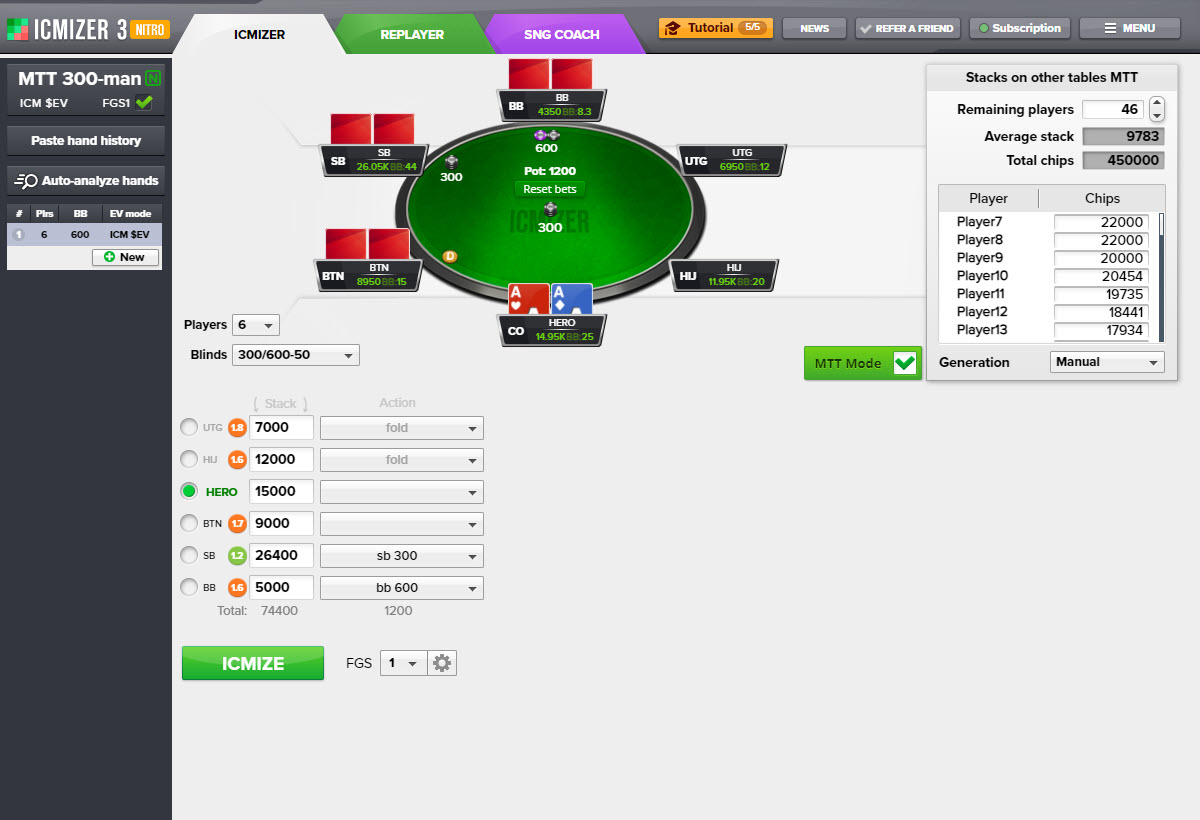
Do you think this player can push as wide as our chip leader, or close to it? This is their shoving range:
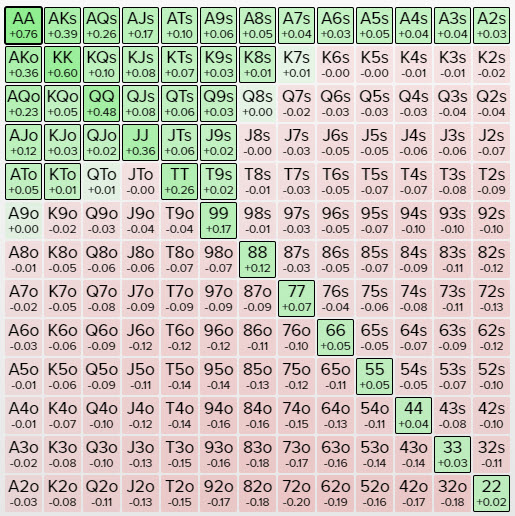
It’s actually a relatively tight range, there are some Kxs hands and T9s hands that are marginal pushes and probably would not be played in real life, but for the most part they have to stick to big Ax and pairs. Hands that block the calling range or already have showdown value.
In this example, this is how wide the chip leader can call:
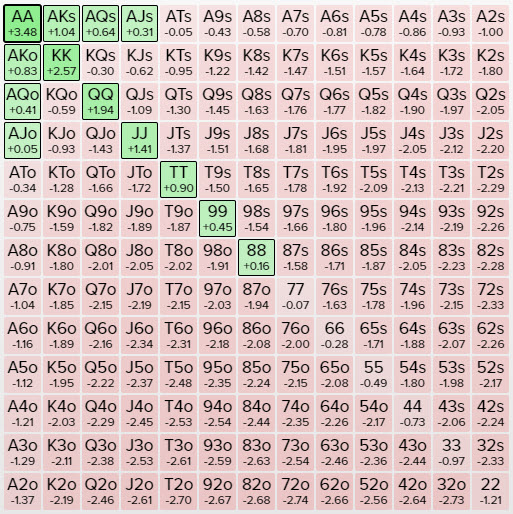
They can profitably call with 88+ and AJ+. When the situation was reversed, the 2nd leader could only call with 99+, AJ+ and ATs. It is not a dramatic difference in the calling range because neither player is happy about getting all-in against each other. The chip leader’s Bubble Factor to call is 1.2 in this example and it is 1.6 for the 2nd chip leader when the situation is flipped around. You can see the Bubble Factors of each player after you solve a spot next to their chip stack:
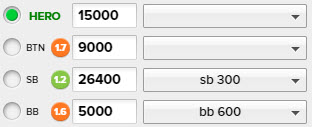
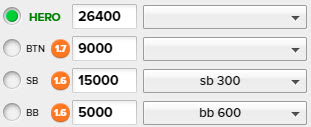
Being 2nd in chips is a good situation, but whenever a player left to act ahead of you can bust you, you have to exercise caution with your shoving ranges. You do not want to invite a needlessly volatile spot when you are so close to securing a payout.
One final example, this time the table makeup is the same as before but we have moved the stacks around so that the chip leader has folded leaving the 2nd in chips to act without fear of busting. This is what it looks like in ICMIZER. You can find the solve here.
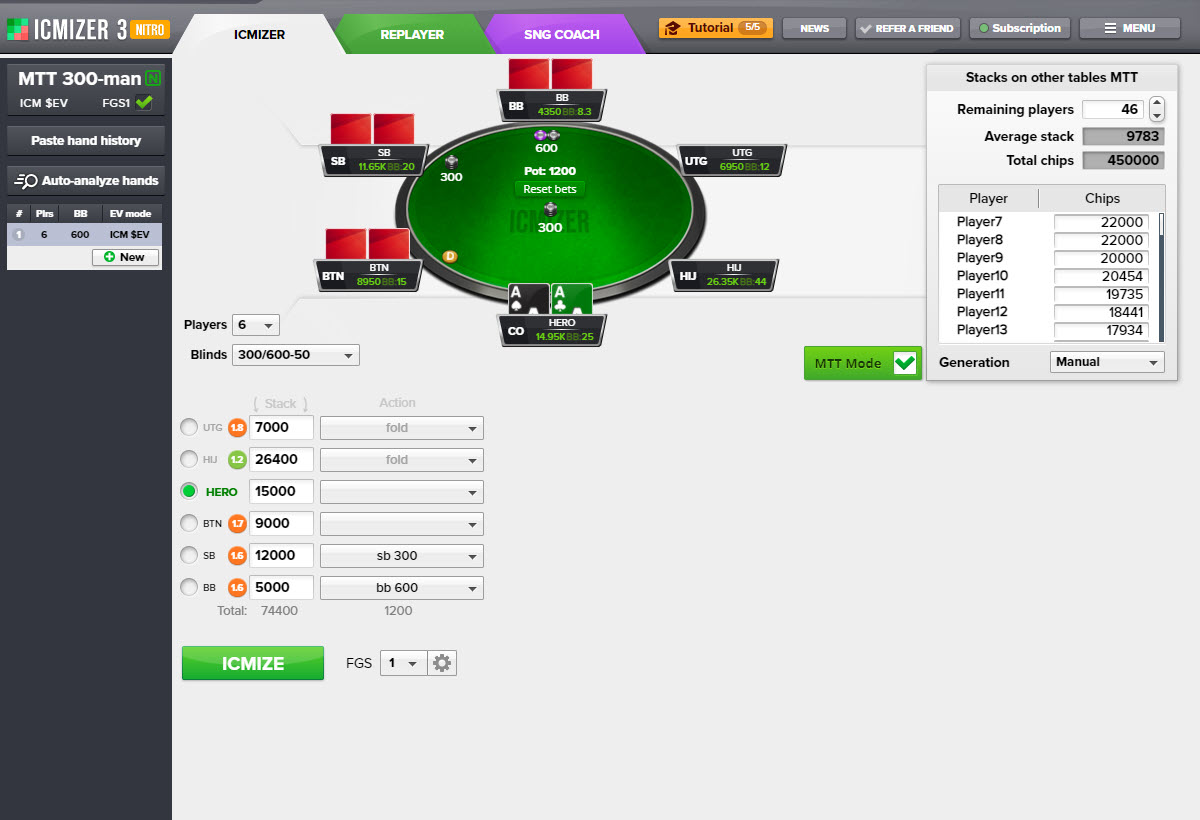
And this is what the 2nd in chips shoving range looks like:
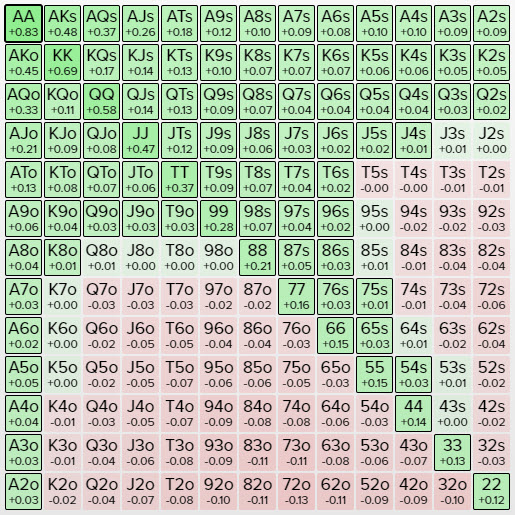
This is an almost identical range to when the overall chip leader was in the Cutoff. The profitability of each hand is actually higher, which is mostly due to the players behind being shorter than they were in the chip leader example and also less big blinds being in play (this is a lesson for another day but the shallower your stack, the more profitable most hands become to play because you can shove more hands and pick up a bigger amount relative to your stack).
The key takeaway here is that when you cannot be eliminated in the hand, whether you are the overall chip leader or just the biggest stack left in the hand, you can push much wider than anyone on the table. When the players who cover you are out of the hand, you become the defacto chip leader.
Final thoughts
You should be more aggressive if you are a big stack on the bubble, most players know this but only the players who have studied ranges like this with tools like ICMIZER know just how wide a big stack can push.
If you don’t push as wide as you should you will, of course, make it into the money with ease. If you play hyper aggressive as a big stack you will always run the risk of running into a big hand. This is not the right mindset to take into this situation.
When you have the chip lead in a scenario with a lot of ICM pressure, you are essentially playing a different game to the rest of your table. Your mission is about building a big enough stack to make a run at the final table, their mission is survival. You only have to look at how tight the rest of the table has to call, and how much tighter even 2nd in chips has to be against you, to realise this.
One of the fundamental maxims of ICM is that the more chips you have, the less each is worth. This is particularly true on the bubble. If you are short stacked on the bubble with 10 big blinds and the mincash is $200, your equity might be $300 making each chip worth $30. If you have 50 big blinds on the bubble, your equity might be $450, making each chip worth $9. This is why you can be so aggressive with your chips but your opponents have to play so tight, they are worth less to you, so you should put them to good use without fear of elimination.
All the ranges we have seen today assume everyone at the table is playing Game Theory Optimal (GTO) poker. In reality most big stacks are not pushing as wide as they should, and most short stacks will overcall or overfold on the bubble. In ICMIZER, you can adjust the calling and shoving ranges based on how you think your opponent’s play to get an adjusted range for how you should play. Broadly speaking the wider they call the tighter you should shove, and vice versa, but you do see inflection points where the opposite is true. This is why you need to study lots of these spots to develop an instinct for how to play them in real life at the tables.
If the findings in today’s article surprise you, you can quickly and efficiently learn how to play bubbles and more with an ICMIZER subscription. You can review your own plays and also develop quick muscle memory when you are at the tables using the MTT Coach feature. Given how much equity a lot of players give away by playing too tight as a big stack in high ICM moments, you can easily see how a subscription pays for itself. If you make just one big final table finish because of a stack you built on the bubble, the subscription pays for itself.